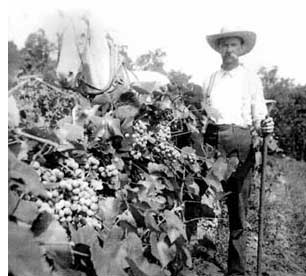About Missouri Wine
Our Roots Go Deep
The wineries in and around the historic German community of Hermann are the heart and soul of Missouri Wine Country, accounting for about a third of the state’s total production. Their story is rooted in a fascinating chapter of America’s winemaking history.

Thousands of acres of vineyards once covered the hills in and around Hermann. Photo courtesy of the Edward Kemper Collection, Western Historical Manuscript Collection, Columbia, MO.
In 1837 a band of German settlers from Philadelphia arrived at the site of their new colony expecting a land of milk and honey. Instead, they stepped off the last steamboat of the season into a howling wilderness. Inspired by the tangles of wild vines that covered the craggy hillsides, the resourceful Germans planted grapes and began making wine.
Town fathers nurtured the infant wine industry by selling “grape lots,” vacant city lots a settler could buy or $50, interest free, over a five-year period. The only condition was that the lot had to be planted in grapes.
A total of 600 grape lots eventually were sold-the entire town was growing grapes, building wine cellars and making wine. Home wine cellars were common, and wine halls were a favorite Sunday gathering place where families socialized after church.
The quality of the wines improved dramatically in the 1840s, thanks to the introduction of the first cultivated grape varieties—Isabella, Virginia Seedling, Catawba and Delaware—and the work of George Husmann, a self-taught scientist whose father had purchased a Hermann lot while the family was still living in Germany. Husmann studied soil types and crossed wild and cultivated grapes to create hybrids that could tolerate Missouri’s hot, humid summers and freezing winters. Some of his vines still thrive today at OakGlenn Winery.
Husmann’s research proved invaluable in the 1860s when the vineyards of southern France were devastated by phylloxera, a bug blight spread by aphids. Missouri grape growers shipped 17 carloads of phylloxera-resistant root stock to France. In commemoration of the event, two statutes were erected in Monpellier, France. One depicts a young woman cradling an old woman in her arms-the New World saving the Old World. Husmann, who was recognized by the French government, later moved from Hermann to California, where he became a founding father of the Napa Valley wine industry.
Hermann held its first Weinfest in the fall of 1848, a tradition that continues in today’s Octoberfest celebrations. One early historian recorded his pilgrimage:
“As we arrived there towards evening a six-pounder thundered its greeting and welcome over the hills and valleys. The reports of this success had penetrated into all parts of Missouri where German was spoken at that time, and even visitors from St. Louis, ladies and gentlemen, had come on steamboats.
The next morning an entire cavalcade made its way to the vineyard of Mr. Michael Poeschel, and as a matter of fact, I didn’t regret having traveled the long distance of 20 miles when I beheld the splendid grapes there with my own eyes. His bearing vineyard covered hardly the area of a single acre, but the rows of posts seemed to consist of nothing but a wall of grapes and among them not a single rotten berry was to be found.
The product of the vintage of this small vineyard was a very expensive but good Catawba, which when it is treated right resembles Rhinewine very closely.”
By the turn of the century, Hermann-area winemakers had become wildly successful. Hermann was one of the largest wine producing regions in the world. One-twelfth of all U.S. wines placed on the market in 1904—nearly three million gallons—was from Missouri, and practically all of that was from Hermann. Some 11,000 acres of terraced vineyards covered the hillsides in and around Hermann.
 Stone Hill Winery won the first of eight World’s Fair gold medals in Vienna in 1873. By the turn of the century, Stone Hill was the second largest winery in the country. The winery’s vast network of underground cellars is among the largest in the world.
Stone Hill Winery won the first of eight World’s Fair gold medals in Vienna in 1873. By the turn of the century, Stone Hill was the second largest winery in the country. The winery’s vast network of underground cellars is among the largest in the world.
This golden era came to an abrupt and bitter end in 1919 with passage of the Volstead Act. Prohibition was an unmitigated disaster for Hermann, which like the rest of Missouri felt the full fury of the temperance movement. Hatchet-wielding Carry Nation was from neighboring Kansas, where Civil War animosity still ran high. Local lore has it that the streets ran red as wine barrels were emptied and then destroyed. Even the vineyards were uprooted.
Prohibition and anti-German sentiment from World War I sent the Hermann area reeling into the Great Depression years before the rest of the country. For decades the only evidence of a once-glorious winemaking past was in churches, which were still permitted to make sacramental wine, or hidden away in barns.
A renaissance began in 1965 when Stone Hill Winery reopened 30 years after the repeal of Prohibition. Today, Missouri is home to dozens of wineries and a state-funded Grape and Wine Program where researchers carry on the work began by George Husmann more than a century ago.
Venerable native grape varieties—Norton, Catawba, Niagara, and Concord—have been joined by exciting new French-American hybrids, such as Vidal, Seyval, Vignoles and, most recently, Chardonel, and Missouri winemakers are once again bringing home gold medals from around the globe.
Missouri wine is back, and this time it’s here to stay.


